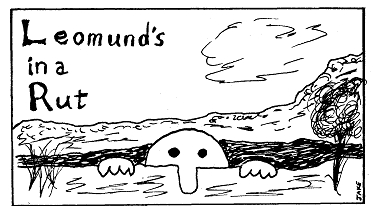
| Dragon | - | Equipment | - | Dragon 36.5 |
There is a long-overlooked aspect of every player and non-player
character’s persona that should no longer remain shrouded in obscurity.
I refer, of course, to the great lack of information, even in a work of
such scope as AD&D, about a character’s
footwear.
According to the Players Handbook,
you can buy high or low boots,
hard or soft soled, for anywhere from 8 s.p. to 2 g.p. Boy, how boring
and uncomplicated can you get?
There can be as many different types of footwear in a campaign as
there are feet to put them on, and each particular shoe, boot or glass
slipper can be made to have its own peculiar properties. You can make
the choice of shoes one of the most important moments in the generation
of a new character (as well it ought to be), or you can inject a new
flavor into an existing campaign by suddenly rendering everyone barefoot:
“You have just set foot on a section of floor coated with an invisible
magic glue. It holds your boots fast, but nothing else will stick to
it.”
Players, being the clear-thinking, ingenious lot we know them to be,
will
surmise that all they have to do is step out of their boots and leave
them
behind. Now you’ve got ‘em barefoot, and when they return to town for
more footwear, you hand ‘em a price list like this:
Shower thongs (5 c.p.)—Good, limited-purpose protection for the
bottom of the feet, but leaves the top of the feet vulnerable to hits
on that
part of the body (For more information on hits to the upper part of
the
foot, see my upcoming article, “A More Complicated System for Determining
Where It Hurts.”)
One-owner sneakers (6-10 c.p. )—Barely a cut above the lowly
thong, this piece of footwear will have from 3-18 holes on the top
and
sole. It will develop new holes at the rate of 1-4 per week, and will
literally fall off a character’s foot when it accumulates a number
of holes
equal to the wearer’s shoe size x 5.
Dimestore loafers (2 s.p.)—These shoes have the look and feel of
footwear costing 10 times as much—until they are purchased and worn
outside the store (so they can’t be returned). There is a 2% chance
cumulative per day that a dimestore loafer will begin to come apart
at
the seams (perhaps causing its owner to do the same thing). There is
a
base 30% chance that the heel will fall off after a week, modified
upward
by .001% for every step the character takes.
(Continued on page 73)